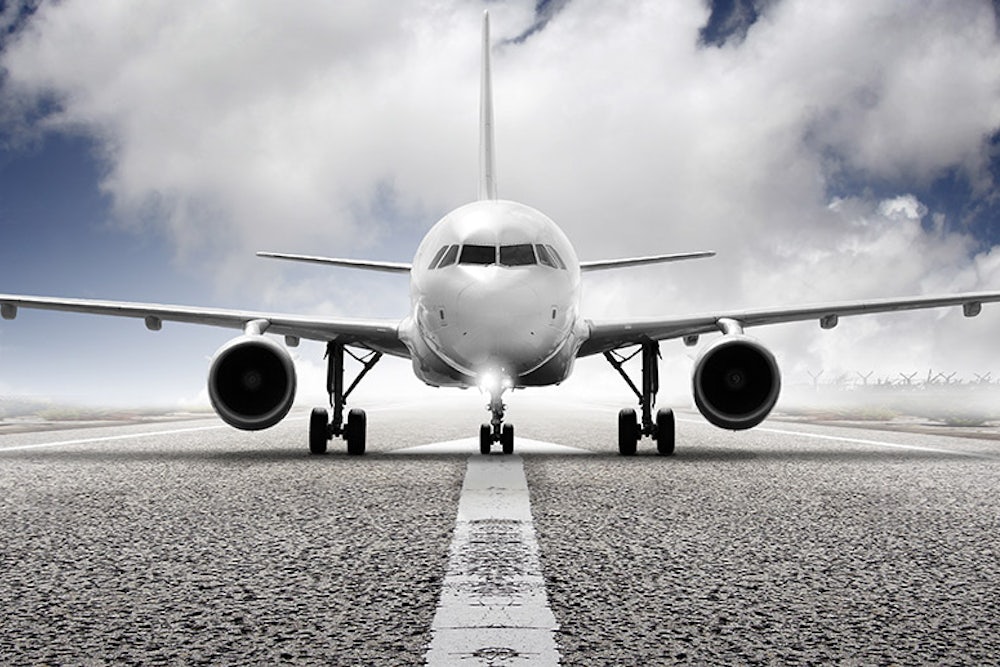Last year, atmospheric carbon pollution rose at its fastest pace in decades, according to a new report from the World Meteorological Organization. Power plants and vehicles are the focal points in fighting climate change, but there's another overlooked source that is finally getting more attention from international and U.S. officials: airplanes.
The aviation sector accounts for a pretty small, but not insignificant, source of carbon pollution. The air travel industry’s footprint contributes to 11 percent of the transportation sector's U.S. emissions levels of says the Center for Biological Diversity. And as carbon pollution rises, so is the airline industry’s share of the problem. Air travel is a fast-growing industry, particularly in the U.S. A 2009 report prepared for the Pew Center on Global Climate Change expected global emissions to quadruple by 2050, if no action is taken.
But there may be hope yet. A 2012 decision by the D.C. District Court determined that the Clean Air Act compelled the Environmental Protection Agency to determine whether airplane emissions pose a public danger. And last week, the EPA took initial steps in curbing aviation emissions by announcing that it would investigate whether the greenhouse gasses emitted by the aviation sector pose a public danger. It will announce its findings in draft form by the end of next April, then finalize it the following year. Advocates say it’s “inevitable” that the EPA will find aviation emissions a public danger.
Since the Clean Air Act has already been used to justify emission regulations from vehicles, power plants, and big buildings, there’s a good chance the EPA will decide it has the power to regulate aviation emissions. But the timeline isn’t likely to be short. Any proposal on curbing emissions is likely to drag beyond this administration, and a new administration might have very different priorities.
International progress on this issue has moved at a glacial pace, said Vera Pardee, a senior attorney with the Center for Biological Diversity’s Climate Law Institute. “After nearly two decades of inaction, we don’t know if the international community will issue meaningful carbon emission standards by 2016,” says Pardee. The International Civil Aviation Organization (ICAO), a United Nations agency, is expected to develop emissions trading standards in 2016 for new aircraft.
A U.S. approach could take any number of forms that mirror international negotiations. Researchers at the University of Southampton offered one solution in a study published in the Atmospheric Environment Journal: slightly more expensive plane tickets. Ticket sales have fallen by 1.3 percent domestically and 0.5 percent internationally between 1979 and 2012, but to keep emissions from continuing to rise, the researchers suggest a tax that would mean a 1.4 percent increase in prices annually. This isn’t very likely, however. Member states of the ICAO have rejected taxing fuel or the industry in the past because of the pricetag involved. It opposed such a plan from the European Union to levy an emissions tax.
The aviation sector seems to be paying attention to these rising concerns. It has touted its efforts to reduce emissions on its own, by improving efficiency and using more biofuels. Nancy Young, vice president of environmental affairs at Airlines for America, said the group is supportive of the ICAO’s efforts, but less so of potential EPA regulatory action. “The standard, no matter what, will cost manufacturers money, and it will cost airlines money as a result because it will increase the prices of aircraft,” Young said, according to The Hill. Republicans, predictably, cast any sort of action as a war on air travel. The “EPA’s eyeing of new standards for aircraft next year underscores the Obama administration's relentless and extreme regulatory climate pursuit,” said Representative Ed Whitfield. “This will add to the growing set of regulatory actions that will raise prices for the goods and services purchased by American consumers."
But, left alone, aviation’s gains in efficiency won’t keep pace with the growth in airline traffic. As Salon’s Lindsay Abrams explains, “industry only increases its efficiency by a little more than 1 percent per year, which is not nearly enough to meet the goals set by the U.S. or the ICAO.” Regulatory action, however, may make the transportation sector better reflect the true cost of the pollution it produces—something that many consumers should better grasp as well.
An earlier version of this article misstated the amount of emissions coming from airplane travel as 11 percent of total U.S. emissions. Airplanes account for 11 percent of the transportation sector's emissions and 2 percent total.
